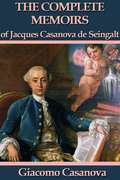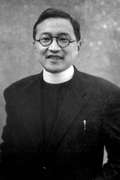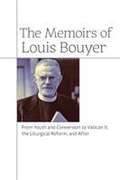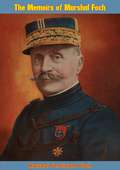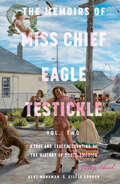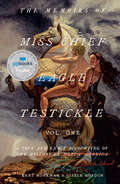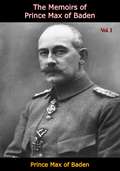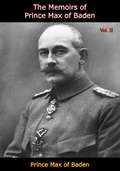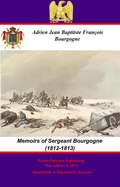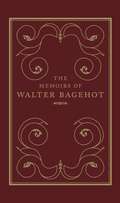- Table View
- List View
The Memoirs of Jacques Casanova de Seingalt: Complete
by Giacomo CasanovaCasanova was an Venetian adventurer and author (1725 - 1798). His Memoirs provide an intimate insight into the life of European society in the eighteenth century. These Memoirs are the history of a unique life, a unique personality, one of the greatest of autobiographies; as a record of adventures. They tell the story of a man who loved life passionately for its own sake: one to whom woman was, indeed, the most important thing in the world, but to whom nothing in the world was indifferent. The bust which gives us the most lively notion of him shows us a great, vivid, intellectual face, full of fiery energy and calm resource, the face of a thinker and a fighter in one. (Introduction, Arthur Symons)
The Memoirs of Jin Luxian
by Jin Luxian William Hanbury-TenisonJin Luxian is considered by many to be one of China's most controversial religious figures. Educated by the Jesuits, he joined the Society of Jesus and was ordained priest in 1945 before continuing his studies in Europe. In 1951 he made the dangerous decision to return to the newly established People's Republic of China. He became one of the many thousands of Roman Catholics who suffered persecution. Convicted of counter-revolutionary activities and treason, he was imprisoned for 27 years and only released in 1982. His subsequent decision to accept the government's invitation to resume his prior role as head of the Shanghai Seminary and then assume the title of Bishop of Shanghai without Vatican approval shocked many Catholics. Now, some thirty years later, still serving as Bishop and regarded as one of the leading figures in the Chinese Catholic Church, Jin recounts formative experiences that provide essential insight into the faith and morality that sustained him through the turbulent years of the late 20th Century. In this volume of memoirs Jin recalls his childhood and education, his entry into the Society of Jesus and formation as a priest, his return to China, imprisonment and, finally, his release and return to Shanghai.
The Memoirs of Louis Bouyer
by Louis Bouyer John Pepino Peter KwasniewskiLouis Bouyer was a major figure in the Church of the last century. These memoirs, which Bouyer wrote in a humble and humorous vein—though without withholding his notoriously sharp pen when needed—allow the reader to enter with him into the great events that shook the Church and the world during the era of upheavals and transformations through which he lived. They amount to an intelligent, sensitive, and pious man’s fascinating chronicle and deep reflection on Christianity’s life and travails in a world committed to modernity. <p><p>Bouyer here tells us the full and varied story of a life devoted to the discovery of the sources and Tradition of the Church in doctrine, spirituality, liturgy, and scripture.
The Memoirs of Louis XV/XVI, Volume 3
by Madame HaussetBeing Secret Memoirs of Madame du Hausset, Lady's Maid to Madame de Pompadour, and of an unknown English Girl and the Princess Lamballe
The Memoirs of Louis XV/XVI, Volume 5
by Madame HaussetBeing Secret Memoirs of Madame du Hausset, Lady's Maid to Madame de Pompadour, and of an unknown English Girl and the Princess Lamballe
The Memoirs of Louis XV/XVI, Volume 6
by Madame HaussetBeing Secret Memoirs of Madame du Hausset, Lady's Maid to Madame de Pompadour, and of an unknown English Girl and the Princess Lamballe
The Memoirs of Marie Antoinette, Volume 2
by Madam CampanMEMOIRS OF THE COURT OF MARIE ANTOINETTE, QUEEN OF FRANCE Being the Historic Memoirs of Madam Campan, First Lady in Waiting to the Queen
The Memoirs of Marie Antoinette, Volume 5
by Madam CampanMemoirs of the court of Marie Antoinette, Queen of France
The Memoirs of Marshal Foch
by Marshal Ferdinand FochThe Commander-in-Chief of the Allied armies, the great strategist who directed the final victory, declined to publish his memoirs during his lifetime. Upon his death, his family at first intended to withhold his manuscript for ten or fifteen years, but the advice of the Marshal’s friends prevailed.So this, the final word on the winning of the great war, was released in 1931, just two years after Marshal Foch’s death.At first the Marshal planned to write a complete history, but he had neither the time nor the strength to complete so large a work. And it is fortunate for posterity that he did not. Others can collect and collate official documents. We have here what Foch alone could have written, his personal story of the war based solely upon his own experience.And it becomes apparent that Foch was not only the great commander and the leading strategist of his time but a writer with a sense of style and a graphic use of words that make his record one of the most moving and dramatic accounts of the great war.On certain details Foch’s views may be questioned, but his story of the victory may well be called the final word. Only the leader of ten million men can speak from the vantage of supreme command.Special maps prepared by the French War Office, unpublished photographs, and facsimiles of the Armistice are included.
The Memoirs of Miss Chief Eagle Testickle: A True and Exact Accounting of the History of Turtle Island
by Kent Monkman Gisèle GordonFrom global art superstar Kent Monkman and his longtime collaborator Gisèle Gordon, a transformational work of true stories and imagined history that will remake readers' understanding of the land called North America.For decades, the singular and provocative paintings by Cree artist Kent Monkman have featured a recurring character—an alter ego of sorts, a shape-shifting, time-travelling elemental being named Miss Chief Eagle Testickle. Though we have glimpsed her across the years, and on countless canvases, it is finally time to hear her story, in her own words. And, in doing so, to hear the whole history of Turtle Island anew. The Memoirs of Miss Chief Eagle Testickle: A True and Exact Accounting of the History of Turtle Island is a genre-demolishing work of genius, the imagined history of a legendary figure through which a profound truths emerge—a deeply Cree and gloriously queer understanding of our shared world, its past, its present, and its possibilities.Volume Two, which takes us from the moment of confederation to the present day, is a heartbreaking and intimate examination of the tragedies of the nineteenth and twentieth century. Zeroing in on the story of one family told across generations, Miss Chief bears witness to the genocidal forces and structures that dispossessed and attempted to erase Indigenous peoples. Featuring many figures pulled from history as well as new individuals created for this story, Volume Two explores the legacy of colonial violence in the children&’s work camps (called residential schools by some), the Sixties Scoop, and the urban disconnection of contemporary life. Ultimately, it is a story of resilience and reconnection, and charts the beginnings of an Indigenous future that is deeply rooted in an experience of Indigenous history—a perspective Miss Chief, a millennia-old legendary being, can offer like none other. Blending history, fiction, and memoir in bold new ways, The Memoirs of Miss Chief Eagle Testickle are unlike anything published before. And in their power to reshape our shared understanding, they promise to change the way we see everything that lies ahead.
The Memoirs of Miss Chief Eagle Testickle: A True and Exact Accounting of the History of Turtle Island
by Kent Monkman Gisèle GordonINSTANT NATIONAL BESTSELLERFrom global art superstar Kent Monkman and his long-time collaborator Gisèle Gordon, a transformational work of true stories and imagined history that will remake readers&’ understanding of the land called North America.For decades, the singular and provocative paintings by Cree artist Kent Monkman have featured a recurring character—an alter ego of sorts, a shape-shifting, time-travelling elemental being named Miss Chief Eagle Testickle. Though we have glimpsed her across the years in films and on countless canvases, it is finally time to hear her story, in her own words. And, in doing so, to hear the whole history of Turtle Island anew. The Memoirs of Miss Chief Eagle Testickle: A True and Exact Accounting of the History of Turtle Island is a genre-demolishing work of genius, the imagined history of a legendary figure through which profound truths emerge—a deeply Cree and gloriously queer understanding of our shared world, its past, its present, and its possibilities.Volume One, which covers the period from the creation of the universe to the confederation of Canada, follows Miss Chief as she moves through time, from a complex lived experience of Cree cosmology to the arrival of European settlers, many of whom will be familiar to students of history. An open-hearted being, she tries to live among those settlers, and guide them to a deeper understanding of the interconnectedness of all beings and the world itself. As their numbers grow, though, so does conflict, and Miss Chief begins to understand that the challenges posed by the hordes of newly arrived Europeans will mean ever greater danger for her, her people, and, by extension, all of the world she cherishes.Blending history, fiction, and memoir in bold new ways, The Memoirs of Miss Chief Eagle Testickle are unlike anything published before. And in their power to reshape our shared understanding, they promise to change the way we see everything that lies ahead.
The Memoirs of Prince Max of Baden Vol. I (The Memoirs of Prince Max of Baden #1)
by Prince Max of Baden Baden W. M. CalderThis is Volume I of II comprising the authorized translation of Prince Max of Baden’s German memoirs published in 1927 (original German title: Erinnerungen und Dokumente). This translation was first published in 1928.“NOT long after the Revolution, when it became clear that an essential share of the blame for the German collapse would be ascribed to me, I decided to give a public account of my stewardship. I soon realized that I could only explain the actual connection of events both to the German people and to myself if I submitted the charges made against me to a careful examination, and also made up my mind to understand the point of view of my opponents.“As early as 1919 I found myself compelled to define my attitude to the disputed happenings of 9th November. I did this in a publication which was printed in all the newspapers but was virtually hushed up in the controversial literature.“In the study and self questioning of eight years I think I have got as near the truth as I can.“In the course of my work my apologia has grown into something different—an account based on original sources of that fateful epoch of the history of Germany in which I was involved. I put my trust in the weight of the facts.” (Prince Max of Baden)
The Memoirs of Prince Max of Baden Vol. II (The Memoirs of Prince Max of Baden #2)
by Prince Max of Baden Baden W. M. CalderThis is Volume II of II comprising the authorized translation of Prince Max of Baden’s German memoirs published in 1927 (original German title: Erinnerungen und Dokumente). This translation was first published in 1928.“NOT long after the Revolution, when it became clear that an essential share of the blame for the German collapse would be ascribed to me, I decided to give a public account of my stewardship. I soon realized that I could only explain the actual connection of events both to the German people and to myself if I submitted the charges made against me to a careful examination, and also made up my mind to understand the point of view of my opponents.“As early as 1919 I found myself compelled to define my attitude to the disputed happenings of 9th November. I did this in a publication which was printed in all the newspapers but was virtually hushed up in the controversial literature.“In the study and self questioning of eight years I think I have got as near the truth as I can.“In the course of my work my apologia has grown into something different—an account based on original sources of that fateful epoch of the history of Germany in which I was involved. I put my trust in the weight of the facts.” (Prince Max of Baden)
The Memoirs of Sergeant Bourgogne (1812-1813)
by Anon Pickle Partners Publishing Sergeant Adrien Jean Baptiste François BourgogneThis ebook is purpose built and is proof-read and re-type set from the original to provide an outstanding experience of reflowing text for an ebook reader. Considered by the majority of commentators to be the quintessential personal narrative of Napoleon's disastrous 1812 campaign in Russia. The book charts the progress of the Grande Armée toward it's apogee at the occupation of Moscow, followed by the great fire of Moscow and the looting of the city to the terrible retreat. During the retreat the full horror of the hunger, privation are vividly depicted, not only in Bourgogne's own sufferings, but also those of his friends and countrymen. He stumbles through trials that proved too much for most those around him, whilst maintaining a haunting ability to describe the torments that try him. This account written partly in captivity in 1813, after capture at the battle of Dessau in 1813 and partly from letters he sent to his family during 1812, its historical significance and value cannot be over stated. Text taken from book published in 1899 by William Heinemann, London
The Memoirs of Walter Bagehot
by Frank ProchaskaWalter Bagehot (1826-1877) was a prominent English journalist, banker, and man of letters. For many years he was editor of "The Economist," and to this day the magazine includes a weekly "Bagehot" column. His analyses of politics, economics, and public affairs were nothing short of brilliant. Sadly, he left no memoir. How, then, does this book bear the title, "The Memoirs of Walter Bagehot"? Frank Prochaska explains, "Given my longstanding interest in Bagehots life and times, I decided to compose a memoir on his behalf. " And so, in this imaginative reconstruction of the memoir Bagehot might have written, Prochaska assumes his subjects voice, draws on his extensive writings (Bagehots "Collected Works "fill 15 volumes), and scrupulously avoids what Bagehot considered that most unpardonable of faults--dullness. A faux autobiography allows for considerable license, but Prochaska remains true to Bagehots character and is accurate in his depiction of the times. The memoir immerses us in the spirit of the Victorian era and makes us wish to have known Walter Bagehot. He is, Prochaska observes, the Victorian with whom we would most want to have dinner.
